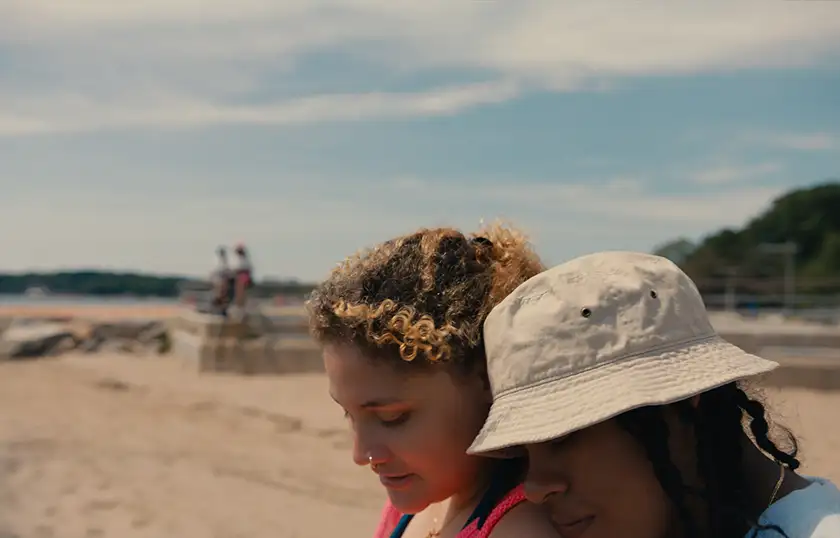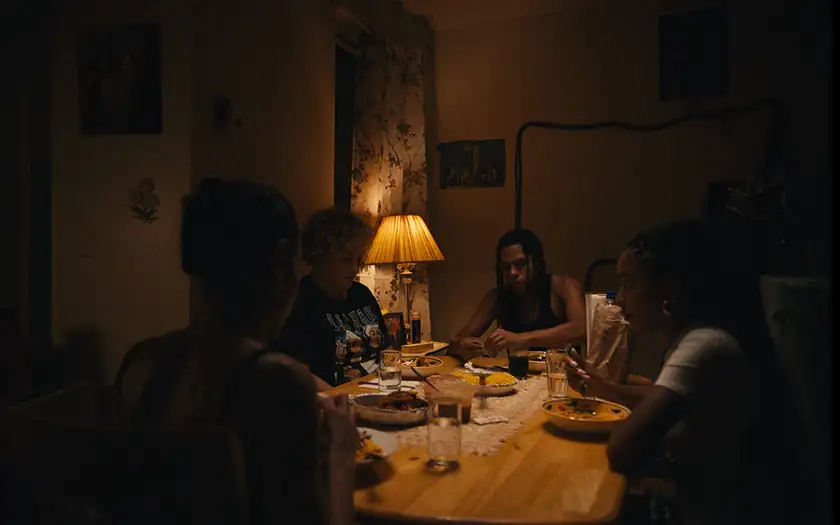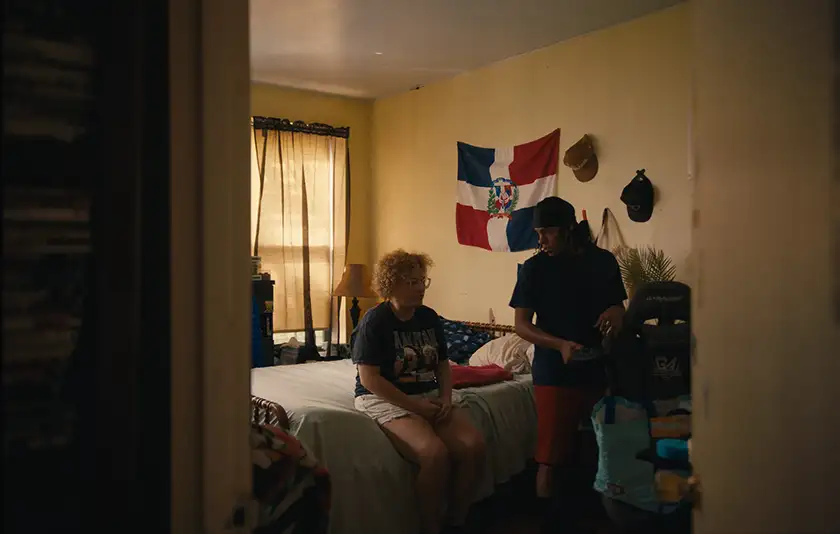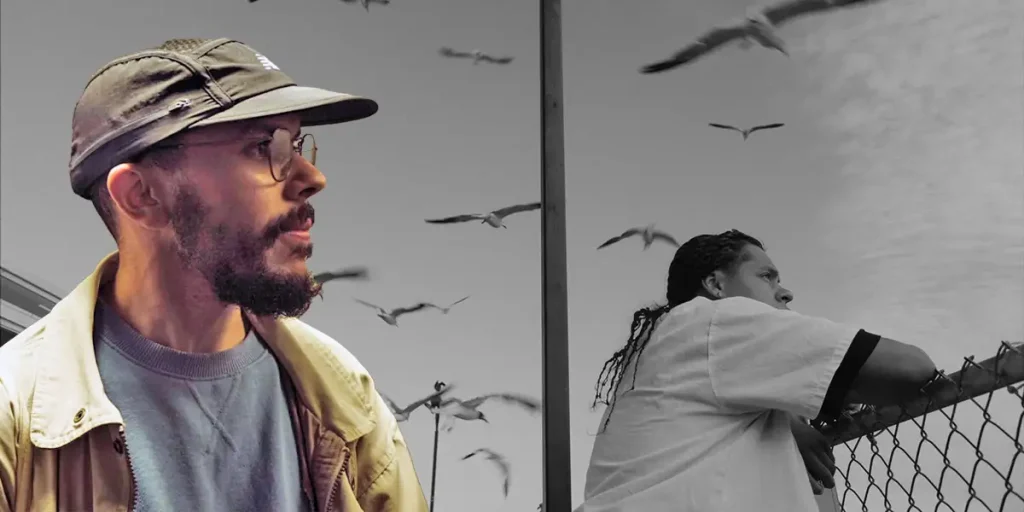In this Berlin Film Festival interview with Joel Alfonso Vargas, the writer-director tells us about his debut feature Mad Bills to Pay (or Destiny, Dile Que No Soy Malo).
Mad Bills to Pay (or Destiny, Dile Que No Soy Malo), writer-director Joel Alfonso Vargas’s feature debut, tells the charming, layered story of nineteen-year-old Rico (Juan Collado), who belongs to a Dominican-American community in the Bronx. It’s summer, and Rico spends his days selling homemade “nutcracker” cocktails on the beach, hitting on girls, and playing video games in his room, at the house he shares with his “Mami” Andrea (Yohanna Florentino) and his sister Sally (Nathaly Navarro). One day, destiny literally comes knocking on his door when his teen girlfriend, Destiny (Destiny Checo), discovers that she’s pregnant and moves in with his family.
Clearly, Rico’s idea of fatherhood has been shaped by an absent father and the patriarchal society in which he lives, as the moment he realizes that he’s going to be a father, he becomes a living embodiment of toxic masculinity despite his best intentions. Yet, even with his complete disregard for Destiny’s needs, and his inability to take responsibility for anything or even keep a job for more than a couple of days, we can’t help but feel for him, as we understand that his behavior is a direct result of his distorted idea of what it means to be the “man of the house.” Juan Collado and Destiny Checo excel as the leads of a stunning, thought-provoking, surprisingly funny film that feels like it’s unfolding in real time, and whose characters are so well-rounded that you’ll be sad when the credits roll and your time with them is over.
After winning he NEXT Special Jury Award at the 2025 Sundance Film Festival, Mad Bills to Pay had its International Premiere at the Berlin Film Festival, where we sat down with writer-director Joel Alfonso Vargas. In this interview, he tells us about the origins and themes of the film, his approach to rehearsals and space, the production design, the value of sharing underrepresented experiences, and more. Keep scrolling for the interview, and click here to read our review of the movie!
Joel Alfonso Vargas on the Origins of the Film and How Audiences Have Been Responding to It
Congratulations for this fantastic film, and for the Sundance Award and now the Berlinale screening! Did you expect the film to be so well received and what do you think it is about it that’s resonating with audiences so much?
Joel Alfonso Vargas: That’s a good question! We worked on this film for almost two years; I saw the cut almost two hundred times, and over time, a film becomes less impactful to you. By the end of that process, I was asking myself, “What did we make?,” and questioning everything. But then, we got into Sundance. I was like… Okay, this is interesting: people are responding to it. And then, of course, when we showed it at the festival, the audience really responded to it in just how much they were laughing with it, and the humor was registering too.
We had some Latin-American and Dominican-American people in the audience, but we screened it five or six times at Sundance, and most of those screenings were sold out, so it was diverse audiences. We got so much feedback from people whose experiences were similar to those of the family depicted in the film: they’d come up to us and tell us, “Oh, I really felt represented,” or “That’s how it was in my family.” Some of them grew up in New York and have now been living in Utah for twenty years, and they told us that the movie reminded them of growing up. I would say the film has a charm, which is nice.

I agree! I grew up in Italy and even I felt represented in the way you depict patriarchy, particularly with your protagonist’s behavior. There are points in the film where I wanted to strangle Rico for how he behaves, but you also understand why he is the way because you treat him with compassion.
Where did this character come from?
J.A.V.: I get asked this a lot, and most people think I was a teen dad, but I was not. And I’ve never sold nutcrackers [the cocktails Rico makes and sells on the beach] in my life! [laughs] But I grew up in the Bronx, in a very working-class family, and many of the guys around me were hustlers, teen dads or even teen families who’d have to hustle or just do what they had to do to get by. Some of these guys were my friends; some were my brother’s friends: he’s 10 years older than me. There was always a commonality between all these guys: They were almost walking tornadoes, or walking chaos. Anything that they touched fell apart. That character type just stayed in my head, over the years, and around the pandemic, I thought a lot about my childhood, and the impact of these guys just suddenly just came back to mind. I realized I wanted to tell a story about one of them.
Thematically, we’re trying to understand Rico’s misinterpretation of masculinity, and how that’s really been impacted by a lack of a male figure – or a male role model/father figure – in his life. My parents were teen parents, and I grew up in a very similar way. I know my dad, but we’re not very close, and as a male figure in my life, he wasn’t always there. As you’re becoming a man, you have no guidance, and you don’t know what it means to be a reliable partner. So you make all these mistakes, which is what I’m trying to explore in this film.
Mad Bills to Pay Was “A Real Collaborative Inspiration”
I read that your protagonists were street-cast and that you relied a lot on improvisation.
Joel Alfonso Vargas: It was 50/50 street cast and professionally cast. Yohanna Florentino and Nathaly Navarro, who play Rico’s sister and mom, have more formal on-screen experience. Juan Collado, who plays Rico, has some community theater experience and he’s had some screen exposure. And then, Destiny Checo [who plays Rico’s girlfriend Destiny] had no experience whatsoever.
What was a typical day on set like?
J.A.V.: We rehearsed – not a whole bunch, because we didn’t have a lot of time or money – and everybody got very comfortable with each other. My process of making a movie is that even if we have a script – in this case, we had one, which was partly a beat sheet, so bullet points – during rehearsals, we just break everything, and open it up. “Oh, you don’t think a character would say it this way? Okay, let’s try this way.” And then, we would improvise, with the idea of rewriting the story in rehearsals, together with the cast. Then, we’d go to production, and we’d take these new scenes to the set: that’s how it was most of the time.
The cast’s contribution to the film was immense, because it was a real collaborative inspiration, from the nuances of the dialogue to the blocking [determining where the actors and camera will be on the set and how they will both move]. I would tell people where the limit of the frame was, so that they knew not to go beyond those points, but I never told people where to stand. I gave them the freedom to move. Sometimes I would tell them to use the depth of the frame, to remind them that we were playing in deep focus.
I think it shows, because as a viewer, you feel like these are actual people. As if it were a documentary, and when the film is over, their lives continue.
J.A.V.: Yes, that was the idea.

Joel Alfonso Vargas on the Use of Space in Mad Bills to Pay
I love the way you shot the movie. There are some scenes where you let us stay in some rooms, and Rico’s room in particular, even after the characters have left. As a whole, the way the film is shot just feels very authentic.
Joel Alfonso Vargas: Thank you. I love spaces. I think there’s so much of cinema – at least in the classical, conventional Hollywood approach – that’s just so focused on faces. New York City is such a textured environment. At least in the Bronx, the spaces are so interesting, because they’re falling apart: they’re a little bit old. To me, New York City always feels like a city stuck in time. Space was so important to me [when making this movie]: allowing the audience to not only experience the storytelling, but also the feeling, the textures, and the atmosphere of what it’s like to just be still in a place in the Bronx. I wanted people to have that.
This is so interesting, because you also get a feeling of being stuck in time, in my opinion. Take a scene at the beginning where it’s Rico’s mum’s Birthday, and she gets to make a wish as she blows out the candles: it feels like she’s a teenager again. It just feels like everybody’s stuck in the same cycle, no matter their age.
J.A.V.: Yeah. At the time [of writing and shooting the movie], consciously, I wasn’t thinking about these things. As a screenwriter, I was just thinking about characters and intention, but somehow everything is connected in the end. On the one hand, you have Rico, who doesn’t want to grow up. You have his sister, who wants to grow up too fast. Then you have their mom, who’s turning 40: everyone is having almost a coming of age moment. And Destiny, of course, is about to be a mom, which is huge. It’s almost like everybody is grappling with their maturity in a way, which is interesting. It’s very human.
Going back to spaces, you must have thought a lot about the props you displayed, the design of the flat, and Rico’s room in particular. For example, all the flags everywhere, and the objects that give even the flat such a strong identity.
J.A.V.: I worked with production designer Lia Chiarin, who’s Italian-British. It was tricky: in the beginning, we were trying to create this Latin household, but she was coming from Europe, so she didn’t really know what a Latin American household would look like. She came with a mood board, and when I saw the image, I was just like… “Oh, that’s not it.” Because people think of Latin American culture as a monolith, as if we were all the same: Colombians and Dominicans and Venezuelans… We’re so different. So I had to direct it, but it was just one chat. We looked at some images online, and I showed her some family photos. That’s where it clicked for her; she then designed that apartment all on her own, and when we showed up, I was like: “It’s perfect.”
It was also a lived-in apartment: there was a family that lived in there. The story of that apartment is crazy.
Oh, please tell me more!
J.A.V.: We couldn’t shoot in the original apartment because we had an infestation of cockroaches. We called an exterminator to see if he could fumigate it, because we just didn’t have time [to look for another flat]. If we lost this location, we wouldn’t have had a film, because half of the film takes place in the house. The exterminator arrives and we ask, “How long will it take?” and he says, “Two weeks.” We couldn’t wait two weeks, but we couldn’t shoot it there, because it would have been a health hazard, and I’d never put the crew in danger. So I’m like, “Oh, my God, what do we do?” And then the exterminator says, “I live three streets down the road, and I have a house where I’m living with my family.”
That’s amazing!
J.A.V.: Yeah. The apartment that you see in the movie is the exterminator’s house! Many of the items in Rico’s bedroom and in the living room are his stuff. The caps on the wall, the trophy in the bedroom… Even the way the bed is positioned: we left it the same way. Lia only touched it up very minimally: she added the flag, the curtains and the beads. She did a lot of work, too, but she also kept a lot untouched.

Why Joel Alfonso Vargas Makes Movies: The Importance of “Sharing These Stories”
Why do you make movies?
Joel Alfonso Vargas: I’ve thought a lot about this, and I think it’s evolved over the years. I come from a very working class: statistically, I’m not supposed to be at the Berlinale, premiering a film. It’s so hard to make it into these spaces if you don’t have the right connections or you don’t come from privilege, so to be in these spaces, and to now have a platform… I feel a strong duty to represent my culture and where I come from – which has almost no representation in cinema.
When I was younger, as a filmmaker, I had all these illusions: you want to work in Hollywood, and do [all these important things]. But then, as you grow up and become more mature, you’re like, Wait a second. There’s so much value in my experiences, and the experiences of my family. I just want to bring those stories to light and to share those stories with the world. And in a way, that specificity is what will distinguish my work from everything else.
I feel a real sense of responsibility. I never want to be preachy, or to be that filmmaker who says, “Come to the Bronx and fix poverty.” I just want to show people that this is what life is like. It’s raw and it’s chaotic, but it’s what it is, and there is no judgment. I just want to have these stories also included in the canon of cinema.
This is so important. How do you think the film will be received by the communities you represented?
J.A.V.: We had some Latin American people in Sundance, and the response has been quite good. I’m curious to see how it would play in the Dominican Republic. I’ve shown it to a few Dominican people, and I feel like the “New York, Dominican, American” experience is also very different, because of the diaspora. I’m just so curious, if there’s ever a Dominican premiere, of how it will register there.
This is true in a lot of Latin American cultures, but in the Dominican Republic, people are sometimes unhappy about being represented in a way that makes it seem like they might be undereducated. They want their image to the world to be a very refined image. And maybe for some, that is the case, but for a lot of people, [what I showed in the film] is what life is like. This is how I grew up, and what families looked like. It was very chaotic. My mother was always shouting at me to clean my room, you know? [laughs] And throwing stuff at me!
Thank you for speaking with us!
This interview was edited for length and clarity.
Mad Bills to Pay (or Destiny, Dile Que No Soy Malo) was screened at the Berlin Film Festival on February 17, 2025. Read our Berlin Film Festival reviews and check out our review of the film below!
Header credits: Joel Alfonso Vargas (Adam Pietkiewicz) / Juan Collado in Mad Bills to Pay (or Destiny, Dile Que No Soy Malo) (Killer Films & Perpetuum Films / Berlinale)

